The diets of the Andeans, both in the past and present, have been influenced by a rich history and diverse cultural practices. From the traditional foods of ancient civilizations to the evolution of modern-day cuisines, Andean cuisine has been shaped by cultural influences and environmental factors.
Key Takeaways:
- The Andeans’ diets have been influenced by a rich history and diverse cultural practices.
- Traditional foods and culinary practices have been passed down through generations.
- Andean cuisine showcases diverse flavours and ingredients.
- Staple foods play a crucial role in the Andean diet.
- Andean cuisine has evolved over time, reflecting cultural influences.
History of Food in the Andeans
The history of food in the Andeans is a testament to their deep connection with the land and their ability to adapt to the harsh environmental conditions. For centuries, the Andean people have relied on the rich resources of the region to sustain themselves and create a diverse and nutritious cuisine. Ancient Andeans cultivated crops such as quinoa and potatoes, which were not only essential for their survival but also played a significant role in their cultural and social practices.
According to a study conducted by UC Berkeley archaeologists, these crops, along with llama meat, formed the foundation of the ancient Andeans’ diet. Quinoa, with its high protein and nutrient content, provided a sustainable source of energy, while potatoes offered a versatile ingredient for various culinary creations. Llama meat, prized for its lean quality, offered a vital source of protein in the absence of other domesticated animals. These ancient dietary choices were a result of the Andeans’ resourcefulness and adaptability to the challenging mountainous terrain.
The culinary traditions of the Andeans have evolved over time, influenced by factors such as cultural exchange and colonization. The Andean region has been a melting pot of different cultures, from the Inca civilization to Spanish colonization, each leaving its mark on the local cuisine. As a result, Andean dishes now incorporate a fusion of Indigenous ingredients and flavours with European influences, creating a unique culinary tapestry that reflects the rich history of the region.
The traditional foods of the Andeans are more than just sustenance; they hold a cultural significance that transcends generations. The consumption of quinoa, potatoes, and llama meat not only nourished the body but also represented a deep connection with the land and honored the customs and traditions of the Andean people.
As we explore the history of Andean food, it becomes apparent that the ancient Andeans’ culinary practices were not only a means of survival but also a celebration of their heritage. By understanding their past diets, we can gain a deeper appreciation for the cultural significance of Andean cuisine and the role it plays in shaping the identity of the Andean people.
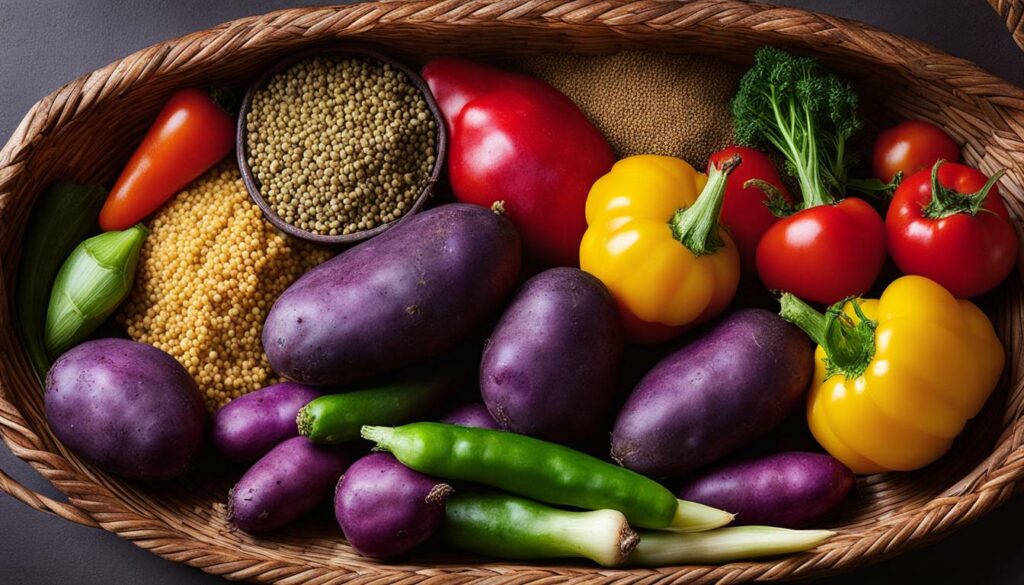
| Traditional Andean Ingredients | Key Culinary Uses |
|---|---|
| Quinoa | Used as a staple grain in soups, stews, and salads |
| Potatoes | Prepared in various ways, including boiling, frying, and mashing |
| Llama Meat | Cooked as a lean source of protein in stews and grilled dishes |
Traditional Andean Recipes
Traditional Andean recipes offer a glimpse into the rich tapestry of flavours and culinary techniques that have been passed down from generation to generation. These recipes not only provide nourishment but also reflect the cultural diversity and history of the Andean region. From hearty stews to vibrant salads, the Andean culinary tradition showcases a harmonious blend of indigenous ingredients and cultural influences.
One popular Andean dish is “Ceviche,” a refreshing seafood salad with a tangy citrus dressing. This recipe typically features fresh fish or shrimp marinated in lime juice, mixed with onions, tomatoes, and cilantro. The acidity of the lime juice “cooks” the seafood, resulting in a delightful combination of flavours. Ceviche is not only a delicious appetizer but also a testament to the coastal influence on Andean cuisine.
| Ingredients | Instructions |
|---|---|
| 1 lb fresh fish or shrimp | 1. Cut the fish or shrimp into bite-sized pieces 2. Place them in a bowl and pour lime juice over them 3. Let it marinate in the fridge for at least 30 minutes 4. Add chopped onions, tomatoes, and cilantro 5. Season with salt and pepper to taste 6. Serve chilled and enjoy! |
Another beloved dish in Andean cuisine is “Lomo Saltado,” a hearty stir-fry that combines tender strips of beef, peppers, onions, tomatoes, and a touch of soy sauce. This fusion of flavours can be traced back to the blending of indigenous ingredients with Asian influences brought by Chinese immigrants. Lomo Saltado is typically served with rice and accompanied by a side of crispy fries, representing the Andean love for both meat and potatoes.
“Lomo Saltado is a true reflection of the Andean culinary tradition, where different cultures and ingredients come together in perfect harmony.” – Chef Marcela Gutierrez
Whether it’s the savoury “Papa Rellena,” a stuffed potato filled with seasoned meat and vegetables, or the vibrant “Choclo con Queso,” grilled corn on the cob served with melting cheese, traditional Andean recipes never fail to excite the taste buds. Each dish tells a story, connecting the present with the past and honouring the culinary heritage of the Andean people.
Experience the Flavors of Andean Cuisine
If you’re looking to immerse yourself in the Andean culinary tradition, why not try making one of these traditional recipes at home? Explore the vibrant flavours, experiment with indigenous ingredients, and savour the taste of a rich cultural heritage. The recipes may have evolved, but they continue to serve as a bridge between the past and the present, preserving the essence of Andean cuisine for future generations to enjoy.

The dietary habits of the Andeans revolve around the consumption of staple foods that provide them with the necessary nutrients to thrive in their challenging environment. These staple foods form the foundation of Andean nutrition, sustaining the indigenous populations for generations. One of the most important staples in the Andean diet is quinoa, a nutrient-rich grain that has been cultivated in the region for thousands of years. Quinoa is not only a source of carbohydrates but also contains essential amino acids, making it a complete protein.
Another staple food in the Andean diet is potatoes. The Andeans have been cultivating potatoes for over 7,000 years, resulting in a rich diversity of potato varieties. Potatoes are not only versatile but also provide a good source of carbohydrates, vitamins, and minerals. Andean communities also rely on llama meat as a source of protein, as it is readily available in the region and has been consumed for centuries. Llama meat is lean and low in cholesterol, making it a healthy choice for the Andeans.
The Andeans have developed sustainable farming practices that allow them to thrive in their harsh environment. Crop rotation and terracing techniques are used to maximize the productivity of their land, ensuring a steady supply of staple foods. These practices have been passed down through generations, preserving the traditional agricultural heritage of the Andeans. The Andean diet is not only nutritionally rich but also culturally significant, reflecting the close connection between the Andeans and their land.
Dietary Habits in the Andeans: A Closer Look
Let’s take a closer look at the dietary habits of the Andeans by examining a table that summarizes the staple foods consumed:
| Staple Foods | Benefits |
|---|---|
| Quinoa | High in protein, essential amino acids, and vitamins |
| Potatoes | Good source of carbohydrates, vitamins, and minerals |
| Llama meat | Lean protein, low in cholesterol |
The Andean diet is a testament to the resourcefulness and adaptability of the indigenous populations. By relying on staple foods that are abundant in their environment, the Andeans have been able to sustain themselves for centuries. Their dietary habits not only provide them with the necessary nutrition but also reflect their deep connection to their land and cultural heritage.
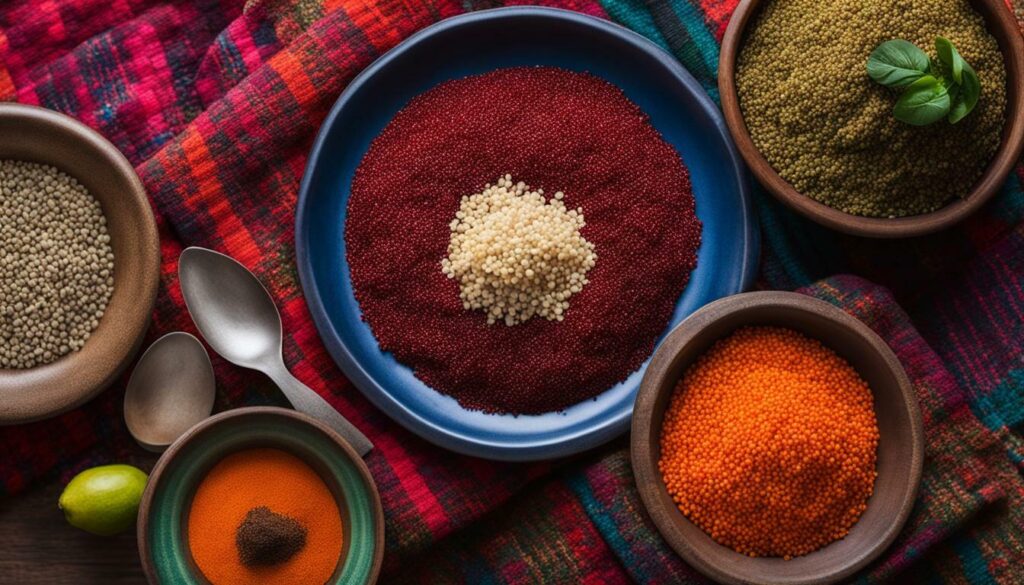
In summary, the Andeans have developed dietary habits that revolve around staple foods such as quinoa, potatoes, and llama meat. These foods provide them with the necessary nutrients to thrive in their challenging environment. Their sustainable farming practices and close connection to the land are reflected in their dietary choices. The Andean diet is not only nutritionally rich but also culturally significant, highlighting the resilience and ingenuity of the Andean people.
Evolution of the Andean’s Diets
The diets of the Andeans have evolved over centuries, reflecting the cultural shifts and adaptations to changing circumstances. This evolution is a testament to their resilience and resourcefulness in utilizing the resources available to them. The Andean region, with its diverse landscapes and climates, has influenced the types of foods that have been cultivated and consumed throughout history.
Various cultural influences have also played a role in shaping the Andean diets. The arrival of the Spanish colonizers introduced new ingredients and cooking techniques, leading to a fusion of indigenous and European flavours. The introduction of quinoa, potatoes, and maize into Europe revolutionized global cuisines, while the Andeans continued to rely on these staple foods as the backbone of their nutrition.
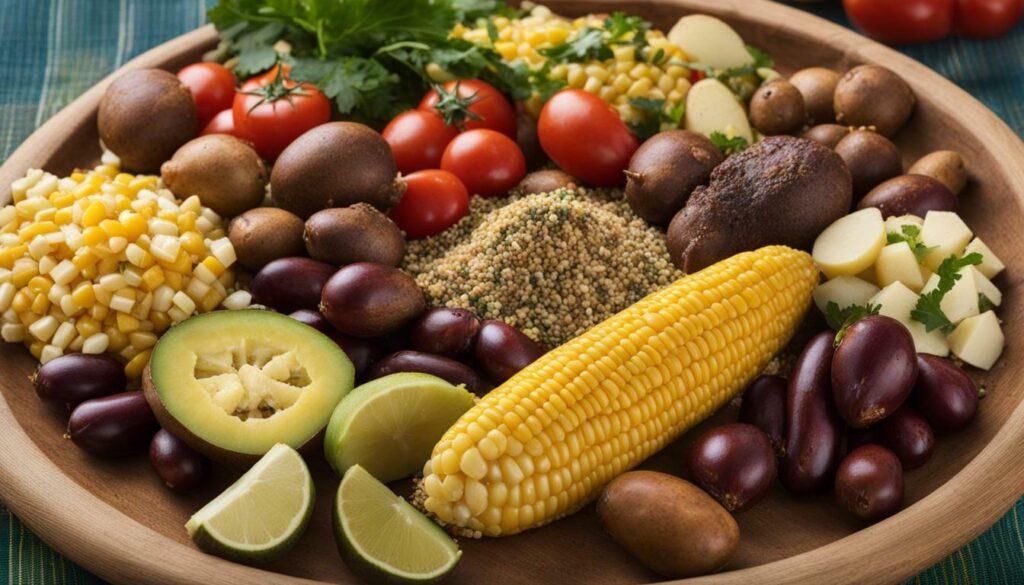
The Andean food culture is deeply rooted in tradition and rituals. Meals are considered a communal experience, bringing people together to celebrate their heritage and share stories. Traditional dishes, such as ceviche, causa, and lomo saltado, showcase the rich flavours and unique ingredients that are characteristic of Andean cuisine.
Today, while the Andean diets have evolved to incorporate elements of modernity and globalization, there is a growing movement to preserve and promote the traditional foods that have sustained the Andean peoples for centuries. Efforts are being made to revitalize ancient farming practices, preserve heirloom seeds, and support local food systems, ensuring the continuation of Andean culinary traditions for generations to come.
Key Takeaways:
- The diets of the Andeans have evolved over centuries, adapting to changing circumstances and cultural influences.
- The Andean food culture is deeply rooted in tradition and communal experiences.
- Traditional dishes showcase the unique flavours and ingredients of Andean cuisine.
- Efforts are being made to preserve and promote traditional Andean foods.
| Traditional Andean Recipes | Popular Andean Dishes |
|---|---|
| Ceviche | Pachamanca |
| Causa | Lomo Saltado |
| Rocoto Relleno | Aji de Gallina |
Modern Day Cuisines in the Andeans
Modern-day cuisines in the Andeans showcase a blend of traditional recipes and modern influences, reflecting the dynamic nature of their food culture. With a rich culinary heritage that spans centuries, the Andean people have preserved and adapted traditional recipes to meet the demands of the contemporary world. Their cuisine is a true reflection of their diverse cultural influences and the bountiful natural resources found in the region.
One of the key aspects of modern Andean cuisines is the use of traditional ingredients such as quinoa, potatoes, and llama meat, which have been staple foods in the Andean diet for thousands of years. These ingredients not only provide essential nutrients but also contribute to the unique flavours and textures that define Andean cuisine.

In addition to traditional ingredients, modern Andean cuisines have also incorporated modern cooking techniques and international flavours. Chefs and home cooks alike have embraced innovative approaches to cooking, blending traditional Andean recipes with global culinary trends. This fusion of old and new creates exciting and vibrant dishes that cater to diverse palates.
To truly appreciate the diversity of modern Andean cuisines, one must explore the regional variations and specialities that exist within the Andean region. From hearty stews and soups to flavorful grilled meats and vibrant vegetable dishes, each Andean community has its own unique culinary traditions that contribute to the tapestry of Andean food culture.
| Traditional Andean Recipes | Modern Andean Fusion |
|---|---|
| Quinoa Soup | Quinoa Salad with Citrus Dressing |
| Lomo Saltado (Stir-Fried Beef) | Lomo Saltado Tacos with Avocado Salsa |
| Chicha Morada (Purple Corn Drink) | Chicha Morada Popsicles |
Whether enjoying traditional dishes passed down through generations or savouring the innovative creations of modern Andean chefs, the cuisine of the Andeans is a testament to their rich cultural heritage and their ability to adapt and evolve with the times.
Cultural Influences on Andean Diets
Cultural influences play a significant role in shaping the diets of the Andeans, as their food culture is closely tied to their rich history and social practices. For centuries, the Andean region has been a melting pot of indigenous traditions and external influences, resulting in a diverse and vibrant culinary tradition. The Andean people’s diets are not only a reflection of their environment but also their cultural beliefs and social structures.
One of the key cultural influences on Andean diets is the long-standing practice of agriculture. The Andean people have cultivated a variety of crops, such as quinoa, potatoes, and maize, for thousands of years. These staple foods have not only provided sustenance but also shaped their culinary traditions. Additionally, the introduction of European ingredients, such as wheat and barley, during the colonial period further enriched their food culture.
Religious beliefs and rituals have also played a significant role in shaping Andean diets. The ancient Andeans had a strong connection to the natural world and believed that certain foods held sacred properties. For example, coca leaves were considered a sacred plant and used in religious ceremonies. The incorporation of these sacred foods into their diets was not only a means of nourishment but also a way to connect with their spiritual beliefs.
The Andean region’s diverse geography and ecosystems have also influenced food choices and culinary practices. From the high-altitude regions of the Andes to the coastal areas, each region has its own unique ingredients and traditional dishes. This geographical diversity has led to the development of distinct regional cuisines within the Andean culture.
Andean Diet: A Reflection of Cultural Heritage
The Andean people’s food culture is deeply rooted in their history and traditions. By embracing their cultural influences, the Andeans have managed to preserve their culinary heritage and pass it down through generations. Today, traditional Andean dishes continue to be cherished and celebrated, not only for their flavours but also for their cultural significance.
As the Andean region continues to evolve and adapt to contemporary influences, there is a growing recognition of the importance of preserving traditional diets and culinary practices. Efforts are being made to promote sustainable farming practices, preserve indigenous crops, and raise awareness about the cultural significance of Andean cuisine.

| Traditional Andean Ingredients | Traditional Andean Dishes |
|---|---|
| Quinoa | Quinoa Salad |
| Potatoes | Papas a la Huancaina |
| Maize | Corn Bread |
| Llama Meat | Lomo Saltado |
“Food is not just about sustenance; it is a reflection of our cultural heritage and a way to connect with our roots. The Andean people have embraced their rich history and diverse cultural influences, creating a culinary tradition that is both flavorful and meaningful.”
Andeans Cuisine Throughout History
The cuisines of the Andeans have evolved significantly throughout history, reflecting the diverse cultural influences and culinary innovations of different periods. From ancient traditions to modern adaptations, Andean cuisine continues to captivate with its rich flavours and unique ingredients.
According to the book “Transforming Diet, Cuisine, and Society,” Andean food has always been deeply intertwined with the region’s history and culture. Over the centuries, the Andeans have relied on native crops such as quinoa, potatoes, and maize for sustenance.
Quinoa, referred to as the “Mother Grain” by the ancient Incas, was a sacred staple in their diet. It is packed with essential nutrients, making it a valuable source of sustenance for centuries.
Another significant influence on Andean cuisine was the arrival of the Spanish conquistadors in the 16th century. The Spanish introduced new ingredients like wheat, rice, and various types of meat, which eventually merged with indigenous flavours to create a unique fusion of cuisines.
Today, Andean cuisine continues to evolve as chefs and home cooks experiment with traditional recipes and incorporate global influences. The diverse cooking techniques and flavours found in modern-day Andean dishes reflect the region’s rich culinary heritage and its openness to new ideas.
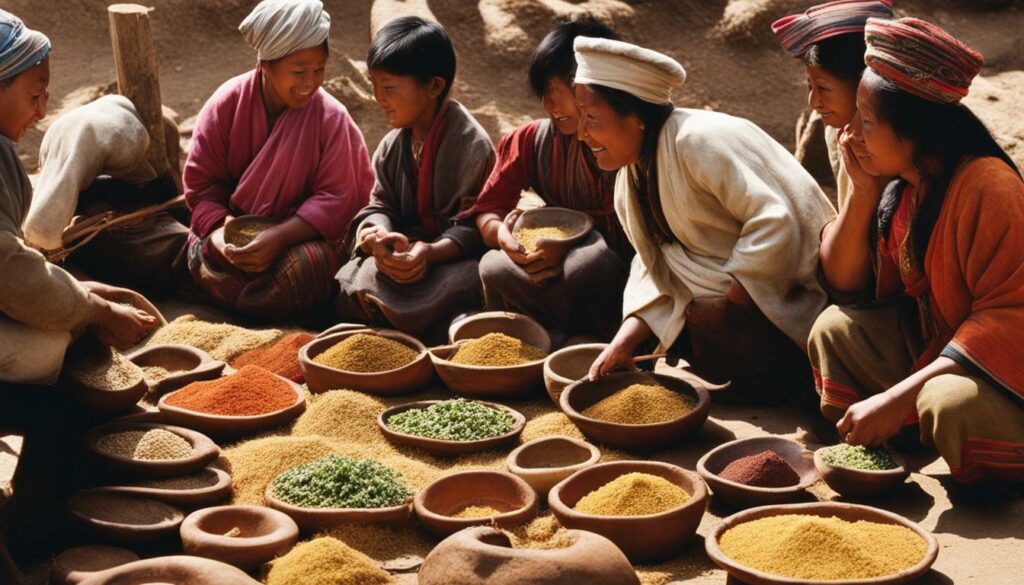
One of the remarkable aspects of Andean cuisine throughout history is the importance placed on indigenous foods and their contribution to human resilience. The Andean people have long recognized the nutritional value and cultural significance of crops such as quinoa, potatoes, and amaranth.
These crops have sustained generations of Andeans, providing essential nutrients and adapting to the harsh mountainous environment. The cultivation and consumption of indigenous foods continue to play a vital role in preserving Andean culinary traditions and ensuring food security in the region.
| Food | Description | Key Nutrients |
|---|---|---|
| Quinoa | A grain-like seed with high protein content and essential amino acids. | Protein, fiber, iron, magnesium |
| Potatoes | A versatile tuber with numerous varieties and culinary uses. | Vitamin C, potassium, fibre |
| Amaranth | A pseudo-grain rich in protein and fibre. | Protein, calcium, iron |
As we explore the fascinating world of Andean cuisine, it becomes evident that the evolution of their diets has been shaped by historical, cultural, and environmental factors. From ancient traditions rooted in indigenous crops to the fusion of flavours brought by colonial influences, Andean cuisine embodies the resilience and adaptability of its people. Today, Andean chefs and home cooks continue to celebrate their rich culinary heritage while embracing new culinary trends, ensuring that the cuisine of the Andeans remains vibrant and exciting.
Traditional Foods in the Andeans
Traditional foods in the Andeans encompass a wide range of ingredients and flavours that have sustained the Andean people for generations. The Andean cuisine is a reflection of the region’s rich cultural heritage and the adaptability of its inhabitants. From the high-altitude peaks to the fertile valleys, the Andean region offers a diverse array of traditional foods that have nourished communities throughout history.
One of the most iconic ingredients in Andean cuisine is quinoa, often referred to as the “mother grain.” This ancient grain is packed with nutrients and has been a staple in the Andean diet for thousands of years. Quinoa is incredibly versatile and can be used in a variety of dishes, from savoury stews to sweet desserts.
Another essential component of the Andean diet is potatoes. The Andean region is home to a vast array of potato varieties, each with its unique flavour and texture. Potatoes are not only a vital source of sustenance but also hold cultural significance for the Andean people. They are used in traditional celebrations and play a role in Andean rituals.
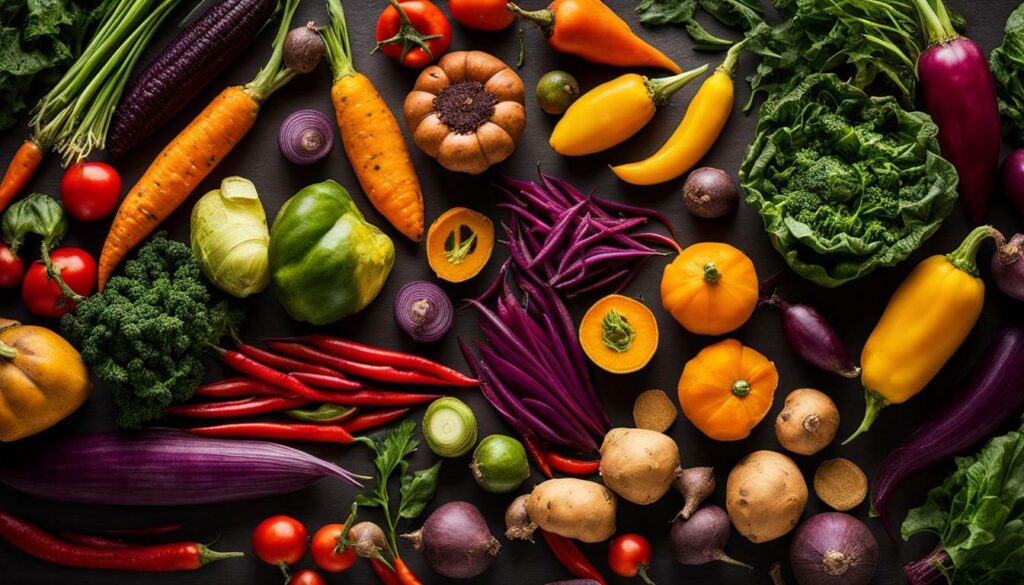
Llama meat is also a traditional Andean ingredient that has been consumed for centuries. Llamas are a valuable source of food in the high-altitude regions, providing lean protein that is essential for the Andean people. Llama meat can be prepared in various ways, including grilling, stewing, or drying to make jerky.
Andean cuisine is not just about specific ingredients; it is a way of life that encompasses traditional cooking techniques and cultural practices. The Andean people have preserved their culinary heritage, passing down recipes and traditions from one generation to the next. Traditional Andean foods not only provide sustenance but also serve as a symbol of cultural identity and resilience.
| Traditional Andean Foods | Flavours | Usage |
|---|---|---|
| Quinoa | Nutty, earthy | Stews, salads, desserts |
| Potatoes | Varies based on a variety | Mashed, roasted, soups |
| Llama meat | Lean, gamey | Grilled, stewed, jerky |
“The traditional foods of the Andeans represent not only nourishment but a profound connection to our ancestral roots. They are a testament to our resilience and our ability to adapt to our environment.” – Andean chef, Maria Castro
“Andean cuisine is a celebration of the region’s biodiversity. The flavors and ingredients found in our traditional dishes tell the stories of our communities and our history.” – Anthropologist, Dr. Juan Perez
Conclusion
In conclusion, the past and present diets of the Andeans reveal a deep connection to their cultural heritage and a remarkable ability to adapt to their environment through their culinary traditions. The rich history of Andean cuisine showcases the resilience and ingenuity of the Andean people, who have passed down their traditional foods and culinary practices for generations.
Through studies conducted by UC Berkeley archaeologists, it has been discovered that staples such as quinoa, potatoes, and llama meat played a vital role in sustaining ancient Andean civilizations for thousands of years. These foods, along with numerous others, continue to be a significant part of the modern-day Andean diet, reflecting their cultural significance and nutritional value.
The Andean people have embraced their food culture, utilizing diverse flavours and ingredients to create a wide array of traditional dishes that are cherished in the region. These culinary traditions have evolved, influenced by cultural factors and environmental conditions, shaping the diets of the Andean people.
Understanding the dietary habits of the Andeans not only provides an insight into their rich food culture but also highlights the importance of traditional Indigenous foods and their contribution to human resilience. By preserving and celebrating their culinary heritage, the Andean people continue to nourish their bodies and honour their cultural identity through the food they consume.
FAQ
What is the book “Transforming Diet, Cuisine, and Society” about?
The book explores the multiple dimensions of food in the Andean past, highlighting the resilience and ingenuity of Andean peoples in the face of challenges.
What did the study by UC Berkeley archaeologists reveal about the diets of ancient Andeans?
The study revealed that quinoa, potatoes, and llama meat were important staples that fueled their civilization for thousands of years.
What does the book “Foodways of the Ancient Andes” examine?
The book examines the mutual production and transformation of food and the cultural significance of meals in the Andean region.
Why do these sources emphasize the importance of traditional Indigenous foods?
These sources emphasize the importance of traditional Indigenous foods because they have contributed to human resilience in the Andean region.
Source Links
- https://uapress.arizona.edu/book/foodways-of-the-ancient-andes
- https://uapress.arizona.edu/2023/04/excerpt-from-foodways-of-the-ancient-andes-2
- https://phys.org/news/2021-11-superfoods-fueled-ancient-andeans-years.html
Read Our Articles On The Other Regions of South America Here:
| Past and Present Diets of the Amazon Basin |
| Past and Present Diets of the Southern Cone |
| Past and Present Diets of the Guianas |



